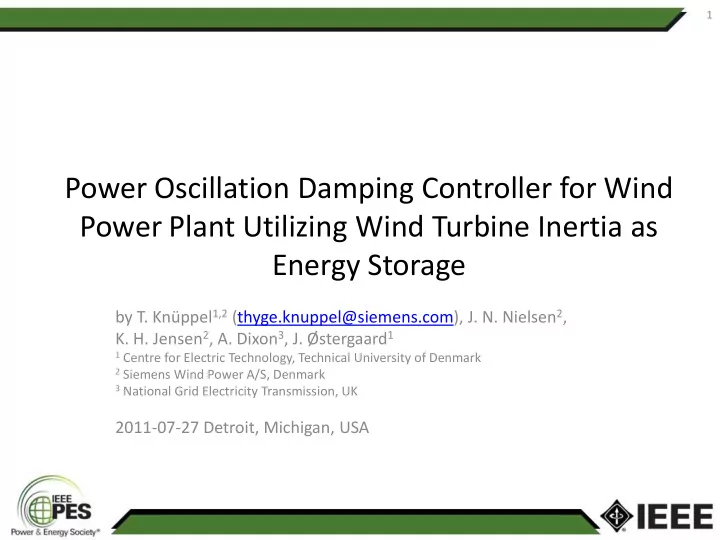

1 Power Oscillation Damping Controller for Wind Power Plant Utilizing Wind Turbine Inertia as Energy Storage by T. Knüppel 1,2 (thyge.knuppel@siemens.com), J. N. Nielsen 2 , K. H. Jensen 2 , A. Dixon 3 , J. Østergaard 1 1 Centre for Electric Technology, Technical University of Denmark 2 Siemens Wind Power A/S, Denmark 3 National Grid Electricity Transmission, UK 2011-07-27 Detroit, Michigan, USA
Industrial PhD Project Participants • Siemens Wind Power A/S • Centre for Electric Technology, Technical University of Denmark • National Grid Electricity Transmission, TSO England/Wales, Scotland 3 year project – finalized by Apr-2012
Power System Oscillations (I) • Behavior well-known for synchronous machines • Large-scale integration of wind power changes fundamental properties of the power system • Increasing cluster size change expectation to “power park modules” • Small-signal stability analysis would have to consider: Large wind power plants are often commissioned in remote areas – Increased penetration displace synchronous generation – – Interfaced through electronic power converters
Power System Oscillations (II) • Wind Power Plant (WPP) Power Oscillation Damping Controller (POD) proposed in literature • Independent control of both active and reactive power • Active and/or reactive power modulation
Active Power POD • Wind is free, produced energy is not • Low energy content in damping signal • High inertia machine • POD subject to operational constraint of the WT
6 Conceptual Study Better understanding needed of • WT mechanical resonance • Interaction with other stabilizing units • Interaction with WT normal operation • WPP distributed and modular • Robustness of WPP POD • Efficiency of damping control
7 Conceptual Study Better understanding needed of • WT mechanical resonance • Interaction with other stabilizing units • Interaction with WT normal operation • WPP distributed and modular • Robustness of WPP POD • Efficiency of damping control → is WPP POD practically feasible and favorable?
Study Case • Location of WPP within inter-area oscillation • Three aggregate feeders • 110 3.6 MW WTs • High and medium wind conditions • Analyze open loop system with induced torque coefficients (ITC)
Inter-Machine Interactions • Low participation of WT mechanical system in system oscillations • No direct coupling between WT mechanical system and synchronous speed • WT operation can induce a torque on the synchronous generators through the network
Modal Analysis • Location of WPP very important for POD efficiency • Similar residue phase characteristics for each feeder • ITC predictions match overall behavior
Damping Performance • Active power output modulated according to POD • Energy exchange seen i rotor speed • Increased damping
Conclusions • Concept of using stored kinetic energy as damping power demonstrated • Positive damping contribution achieved without curtailed operation • Location of WPP very important for efficiency of damping control • Predictions from induced torque calculations capture dominant closed-loop properties • Further work is needed to assess impact, performance, usability, etc. with using WPPs for oscillation damping
Future Work • Consider modular and distributed nature of ∆ P modulation WPPs active power, ∆ P, [MW] 0.2 active power, ∆ P, [MW] 20 Change in PCC Change in WT 0 0 • Consider more complex PCC -0.1 WT1 -20 WT8 power system WT80 -40 -0.3 0 0 1 1 2 2 3 3 4 4 5 5 6 6 7 7 8 8 9 9 10 10 WT88 Time, t [s] WT127 ∆ Q modulation WT133 reactive power, ∆ Q, [Mvar] reactive power, ∆ Q, [Mvar] 40 • Assess sensitivity to 0.2 Change in PCC Change in WT 20 0.1 system changes 0 0 • Assess efficiency of -20 -0.1 0 0 1 1 2 2 3 3 4 4 5 5 6 6 7 7 8 8 9 9 10 10 Time, t [s] damping control
14 Power Oscillation Damping Controller for Wind Power Plant Utilizing Wind Turbine Inertia as Energy Storage by T. Knüppel 1,2 (thyge.knuppel@siemens.com), J. N. Nielsen 2 , K. H. Jensen 2 , A. Dixon 3 , J. Østergaard 1 1 Centre for Electric Technology, Technical University of Denmark 2 Siemens Wind Power A/S, Denmark 3 National Grid Electricity Transmission, UK 2011-07-27 Detroit, Michigan, USA
Recommend
More recommend